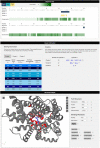3DLigandSite: structure-based prediction of protein-ligand binding sites
- PMID: 35412635
- PMCID: PMC9252821
- DOI: 10.1093/nar/gkac250
3DLigandSite: structure-based prediction of protein-ligand binding sites
Abstract
3DLigandSite is a web tool for the prediction of ligand-binding sites in proteins. Here, we report a significant update since the first release of 3DLigandSite in 2010. The overall methodology remains the same, with candidate binding sites in proteins inferred using known binding sites in related protein structures as templates. However, the initial structural modelling step now uses the newly available structures from the AlphaFold database or alternatively Phyre2 when AlphaFold structures are not available. Further, a sequence-based search using HHSearch has been introduced to identify template structures with bound ligands that are used to infer the ligand-binding residues in the query protein. Finally, we introduced a machine learning element as the final prediction step, which improves the accuracy of predictions and provides a confidence score for each residue predicted to be part of a binding site. Validation of 3DLigandSite on a set of 6416 binding sites obtained 92% recall at 75% precision for non-metal binding sites and 52% recall at 75% precision for metal binding sites. 3DLigandSite is available at https://www.wass-michaelislab.org/3dligandsite. Users submit either a protein sequence or structure. Results are displayed in multiple formats including an interactive Mol* molecular visualization of the protein and the predicted binding sites.
© The Author(s) 2022. Published by Oxford University Press on behalf of Nucleic Acids Research.
Figures




References
-
- Zhou N., Jiang Y., Bergquist T.R., Lee A.J., Kacsoh B.Z., Crocker A.W., Lewis K.A., Georghiou G., Nguyen H.N., Hamid M.N.et al. .. The CAFA challenge reports improved protein function prediction and new functional annotations for hundreds of genes through experimental screens. Genome Biol. 2019; 20:244–223. - PMC - PubMed
-
- Torrance J.W., Macarthur M.W., Thornton J.M.. Evolution of binding sites for zinc and calcium ions playing structural roles. Proteins. 2008; 71:813–830. - PubMed
Publication types
MeSH terms
Substances
Grants and funding
LinkOut - more resources
Full Text Sources

